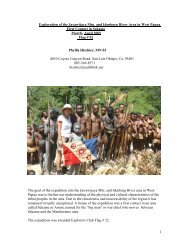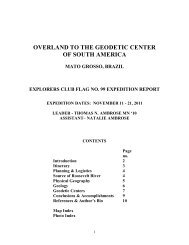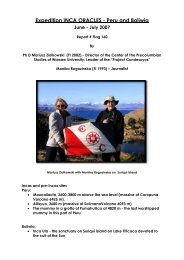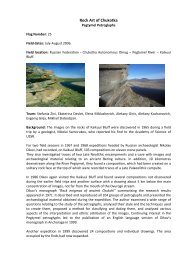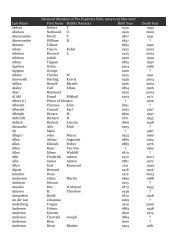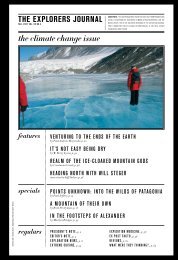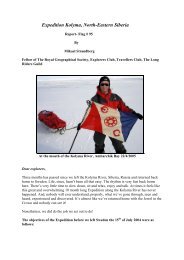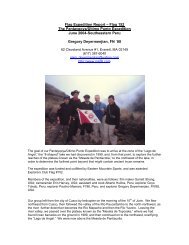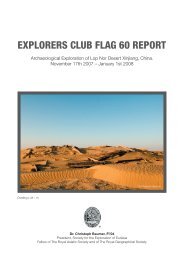the explorers journal - The Explorers Club
the explorers journal - The Explorers Club
the explorers journal - The Explorers Club
Create successful ePaper yourself
Turn your PDF publications into a flip-book with our unique Google optimized e-Paper software.
he snapped up large quantities of beef jerky) and<br />
collects mainly for money. He goes more on his<br />
gut. Arnold’s discovery in 2005 of <strong>the</strong> 648.6 kg<br />
(1,430-lb.) Brenham Meteorite makes him legend<br />
among hunters.<br />
Not surprisingly, a big secondary market exists<br />
for space rocks, because of <strong>the</strong>ir rarity. Collectors<br />
pay from $100 for small fragments to hundreds of<br />
thousands of dollars for large pieces displayed in<br />
museums. Meteorites from <strong>the</strong> asteroid belt between<br />
Jupiter and Mars (<strong>the</strong> most common, and<br />
<strong>the</strong> ones in Odessa) average a few dollars per<br />
gram, while those from Mars and <strong>the</strong> Moon (yes,<br />
<strong>the</strong>y can identify origination by chemical composition<br />
and structure) command $1,000-$2,000 per<br />
gram. Prices, as with any collectible, vary with<br />
condition, type, and age (see “Know Your Space<br />
Rocks,” facing page).<br />
<strong>The</strong>re are <strong>the</strong> celebrity collectors of <strong>the</strong>se<br />
things, too. Musician Sting of <strong>The</strong> Police was<br />
given a 40-kg (88-lb.) shield-shaped Campo del<br />
Cielo meteorite for his birthday in 2008.<br />
While “stones” by far are <strong>the</strong> most prevalent<br />
falls (some 90 percent), <strong>the</strong> majority of finds are<br />
metallics (some 6 percent of falls) because of<br />
52<br />
electronic devices like hand-held metal detectors<br />
and ground penetrating radar (GPR), both of<br />
which we have in Odessa. Hunting for metallics<br />
still can be frustrating, though, as we quickly discover.<br />
More often than not, <strong>the</strong> fruits of our digging<br />
turn out to be nails, bullet shells, bottle caps,<br />
wire—what <strong>the</strong>y call “meteor-wrongs” for obvious<br />
reasons.<br />
Hunting in Odessa is generally safe, with a few<br />
exceptions. Because of <strong>the</strong> arid climate and sandy<br />
shrub geography, myriad snakes inhabit <strong>the</strong> area.<br />
Most are nonpoisonous (of <strong>the</strong> bull variety), so we<br />
take <strong>the</strong> warning with a grain of salt. Later, though,<br />
I almost step on a diamondback rattler which, with<br />
a good bite, can kill a human sans medical treatment<br />
in under an hour.<br />
<strong>The</strong> o<strong>the</strong>r thing to beware of here in oil country<br />
is pipeline. Sarah Cervera, a graduate student<br />
at <strong>the</strong> University of Texas El Paso, hauls out <strong>the</strong><br />
school’s $300,000 ground-penetrating radar<br />
machine—good at identifying and mapping submerged<br />
metal down to about 5 meters (15 feet).<br />
Our team is excited to have such a sophisticated<br />
piece of equipment at its disposal. But time after<br />
time, after identifying metal, our Bobcat digger<br />
Geoff Notkin and Steve Arnold set off in search of more. Photo by Jim Clash.



